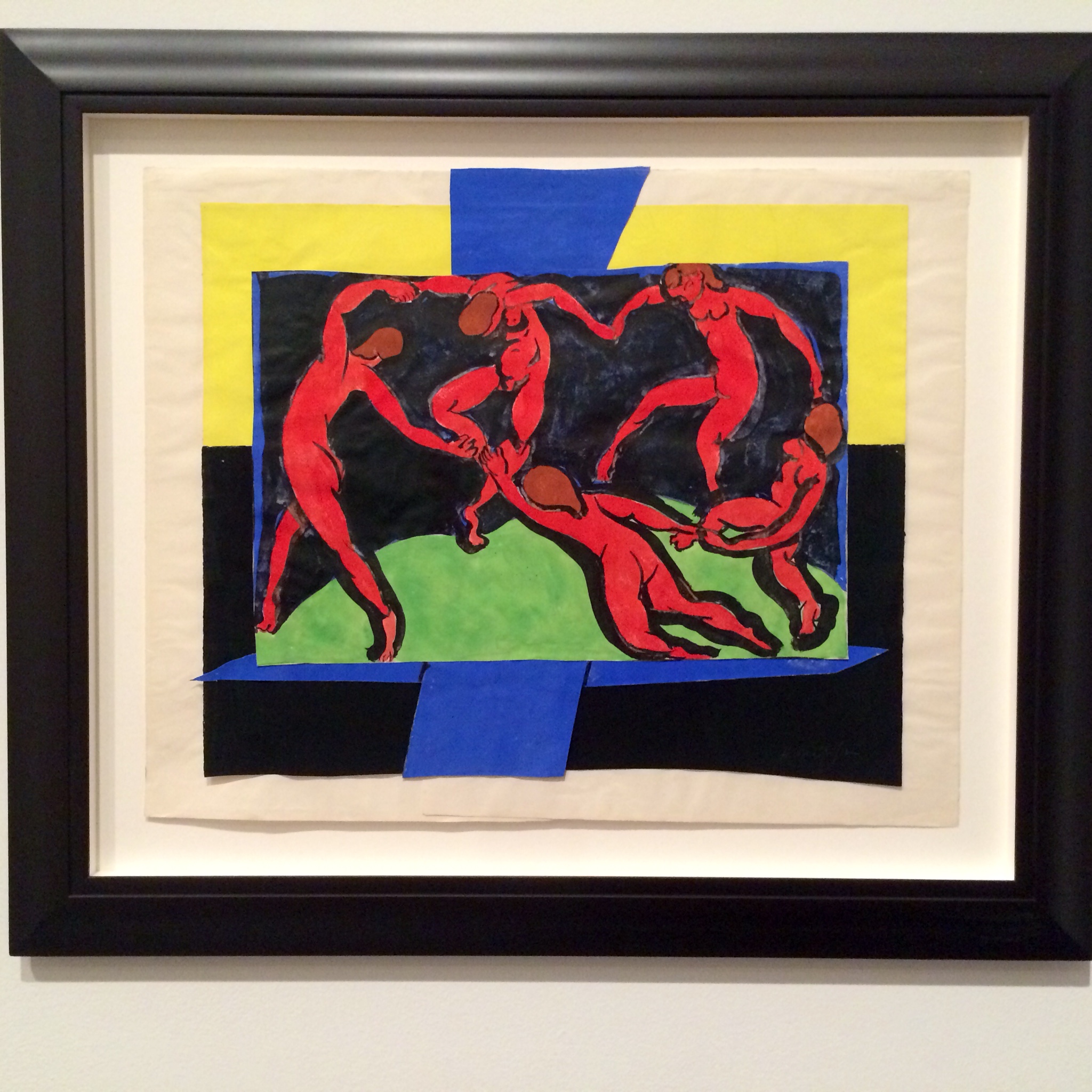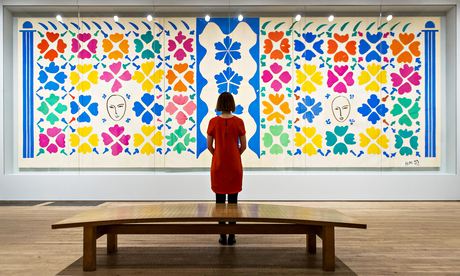 'Much of the beauty that arises in art comes from the struggle an artist wages with his limited medium' Henri Matisse
'Much of the beauty that arises in art comes from the struggle an artist wages with his limited medium' Henri Matisse At a certain point in every artist's career there is a shift in the material and style of the his or her productions for a variety of reasons from experiences, motivations,... In the case of Henri Matisse (31 Dec. 1869- 3 Nov. 1954), considered to be 'a giant of modern art' (1), health complications altered his medium and approach to his artistic expression. The Cut Out series provided Matisse with 'une seconde vie' in his extraordinary burst of creativity. Bound in a wheel chair in his late sixties, the artist replaced his brush with scissors, forever changing Western perception of 'painting'. Matisse's experimental canvases of paper cutouts and collages offered the art goers a new aesthetic.
At a certain point in every artist's career there is a shift in the material and style of the his or her productions for a variety of reasons from experiences, motivations,... In the case of Henri Matisse (31 Dec. 1869- 3 Nov. 1954), considered to be 'a giant of modern art' (1), health complications altered his medium and approach to his artistic expression. The Cut Out series provided Matisse with 'une seconde vie' in his extraordinary burst of creativity. Bound in a wheel chair in his late sixties, the artist replaced his brush with scissors, forever changing Western perception of 'painting'. Matisse's experimental canvases of paper cutouts and collages offered the art goers a new aesthetic.
 In this period, Matisse was not restricted to wall art. 'Among his first adventures...was a cheerful book called Jazz, which Matisse prepared during the war but which was only published in 1947.' (2) Even though only 100 copies were printed, the abstract figures and forms and provisional compositions encouraged the new technique. The artist composed a book filled with creative playful compositions during a time when no 'serious' artist would take on such improvisations of the sort seriously. Matisse's exhibits a creative process through the application of freehand cut shapes secured an undeniable recognition for the style which has withstood time and the exhibition 'Cut Outs' at London's Tate Modern (17 April- 7 September 2014) exemplifies the artist's popularity in the au courant art scene.
In this period, Matisse was not restricted to wall art. 'Among his first adventures...was a cheerful book called Jazz, which Matisse prepared during the war but which was only published in 1947.' (2) Even though only 100 copies were printed, the abstract figures and forms and provisional compositions encouraged the new technique. The artist composed a book filled with creative playful compositions during a time when no 'serious' artist would take on such improvisations of the sort seriously. Matisse's exhibits a creative process through the application of freehand cut shapes secured an undeniable recognition for the style which has withstood time and the exhibition 'Cut Outs' at London's Tate Modern (17 April- 7 September 2014) exemplifies the artist's popularity in the au courant art scene.
 With the help of Lydia Delectorshaya, Matisse arranged the colored forms. The process, which appears relatively easy and straight forward, was laborious. It took Matisse and Lydia two years to produce twenty works. Arranging, pinning, reorganizing and re-attaching was a repeated process that continued until the the moment the shapes were, artistically satisfactory, glued on a fixed surface. The process usually took place in Matisse's studio, as his walls became full of his artwork and floors full of his sculptures. 'By the end of the 1940s, Matisse was using cut-outs for various decorative projects, including wall hangings, scarf patterns, tapestries, rugs, and the designs for the Dominican chapel at Vence.' (3) In fact, the stain glass window cut-out studies for the final glass structure installed in the chapel proved the extent of the technique.
With the help of Lydia Delectorshaya, Matisse arranged the colored forms. The process, which appears relatively easy and straight forward, was laborious. It took Matisse and Lydia two years to produce twenty works. Arranging, pinning, reorganizing and re-attaching was a repeated process that continued until the the moment the shapes were, artistically satisfactory, glued on a fixed surface. The process usually took place in Matisse's studio, as his walls became full of his artwork and floors full of his sculptures. 'By the end of the 1940s, Matisse was using cut-outs for various decorative projects, including wall hangings, scarf patterns, tapestries, rugs, and the designs for the Dominican chapel at Vence.' (3) In fact, the stain glass window cut-out studies for the final glass structure installed in the chapel proved the extent of the technique.
'I don't paint things. I only paint the difference between things'- Henri Matisse

 Walking through the Tate exhibition, an overwhelming feeling of 'I can do that' is sensed in the crowd. It just seems to be a childish approach to art that makes the audience feel as if he or she can reproduce a Matisse. After all, the medium is an odd compositional material to be showing at a museum such as the Tate. After a quarter of an hour, a different mode fills the atmosphere as viewers walk into the Jazz room filled with compositions hung on the museum walls. Not only is the creativity of the technique appreciated, but also the difficulty of forming them. Imagine a subject, and then fabricate how to pre-prepare it by cutting out forms, not stencils, and arranging them stylistically on a blank white canvas. Devise different colors and forms that make up an entire composition, not a monotone singular subject. The difficulty then becomes apparent and an appreciation for Matisse grows. Walking through the exhibition, from room to room, not only do subject change, but so do the surfaces. Initiating from small compositions individually hung to books to sculptures to large scale layouts to the final design for the stained glass window for the Vence chapel.
Walking through the Tate exhibition, an overwhelming feeling of 'I can do that' is sensed in the crowd. It just seems to be a childish approach to art that makes the audience feel as if he or she can reproduce a Matisse. After all, the medium is an odd compositional material to be showing at a museum such as the Tate. After a quarter of an hour, a different mode fills the atmosphere as viewers walk into the Jazz room filled with compositions hung on the museum walls. Not only is the creativity of the technique appreciated, but also the difficulty of forming them. Imagine a subject, and then fabricate how to pre-prepare it by cutting out forms, not stencils, and arranging them stylistically on a blank white canvas. Devise different colors and forms that make up an entire composition, not a monotone singular subject. The difficulty then becomes apparent and an appreciation for Matisse grows. Walking through the exhibition, from room to room, not only do subject change, but so do the surfaces. Initiating from small compositions individually hung to books to sculptures to large scale layouts to the final design for the stained glass window for the Vence chapel.
'Cutting into color reminds me of the sculptor's direct carving'- Henri Matisse
The so-called 'convenient' application of gouache colored paper demonstrates Matisse's unwillingness to let his physical disability to be an obstacle but a means, a purpose, to find a new form of artistic expression. His fame and practice provided the opportunity for the artist to break the norms and experiment art with freedom, unconstrained fun with scissors, papers, and colors.
artwork source:http://www.tate.org.uk/whats-on/tate-modern/exhibition/henri-matisse-cut-outs
http://www.henri-matisse.net/cut_outs.html
http://www.theguardian.com/artanddesign/2014/apr/20/henri-matisse-the-cut-outs-tate-modern-review-laura-cumming
http://itwasagainstherbetterjudgment.blogspot.it/2014/05/i-love-my-life-in-london.html
http://tamarto.com/2014/07/11/exhibit-to-see-matisse-cut-outs/
http://oxfordstudent.com/2014/04/
http://www.nationmultimedia.com/life/When-scissors-replaced-brushes-30231793.html
footnotes:
1. 'Henri Matisse: The Cut-Outs' in The Tate Museum. (London: Tate Organization, 2014) http://www.tate.org.uk/whats-on/tate-modern/exhibition/henri-matisse-cut-outs [Date Accessed 20 July 2014]
2. 'Paper Cut Outs' in Henri Matisse (Succession H. Matisse, 2011) http://www.henri-matisse.net/cut_outs.html [Date Accessed 20 July 2014]
3. Ibid
bibliography:
1. 'Henri Matisse: The Cut-Outs' in The Tate Museum. (London: Tate Organization, 2014) http://www.tate.org.uk/whats-on/tate-modern/exhibition/henri-matisse-cut-outs [Date Accessed 20 July 2014]
2. Millard, Charles. 'The Matisse Cut-Outs' in The Hudson Review, Vol. 31. No. 2 (Summer, 1978), pp. 320-327
3. 'Paper Cut Outs' in Henri Matisse (Succession H. Matisse, 2011) http://www.henri-matisse.net/cut_outs.html
4. Steinerg, Jane. 'Matisse and the Boundary Between Art and Decoration' (winter 2009)


I love your phrase, "It just seems to be a childish approach to art that makes the audience feel as if he or she can reproduce a Matisse." It seems then that Matisse has succeeded in engaging the viewer in a way that connects with even those who might feel intimidated. Thank you for this perspective.
ReplyDeleteTom Jensen
Thank you Tom. I am happy you enjoyed the read and appreciated my analysis.
Delete